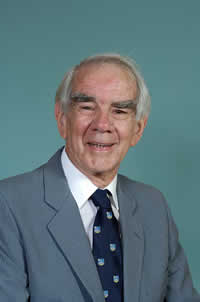
In third year at university we had a few lectures from a new appointee to the biochemistry department, Peter Nossal. He had just finished his Masters of Science degree in Sydney. He was, of course, the older brother of our sometime Sir Gustav Nossal. Peter’s weekly lecture on biological organic chemistry to final-year chemistry students was so good that five of us sneaked in twice a week to Nossal’s regular biochemistry lectures. In turn, these were so good we decided that we wanted to do honours in biochemistry.
Amongst all my work, the first-ever crystallisation of a complex cytochrome but there are so many highlights.
I was eight. I was looking at a neighbour burning leaves in the gutter and wondered, ‘Now, what is smoke all about; what is that magic stuff escaping from the leaves?’ So I thought, ‘Prayers tonight,’ and I asked God. There was no response and I thought again, ‘It is about time that I started to work a few things out for myself.’
Then, at the age of 11, I was reading this sixpenny magazine, a weekly called Modern Wonder, and there was an article about evolution in it. It was fascinating. I had never known anything about evolution. My father came up and said, ‘Son, what is that you are reading?’ I said, ‘Oh, look at this, Dad, an article about evolution.’ He replied, ‘My boy, that is the work of the devil. Have none of it!’ I guess it was at that point that I decided I was going to have to find things out for myself. I was not going to accept such stuff anymore.
Then at high school, for my science prize in the second or third year, instead of an English poetry book, which the headmaster thought I needed, I chose James Stokley’s recent book, Science remakes the world. In it was the description of sulphanilamide, the new wonder drug, of synthetic plastics that would last forever, and of the wonderful insecticide DDT.
Yes, lots of travelling but a late high point came when wife Judy and I — she from her school library job and I from CSIRO — decided to quit formal employment at 60 and have some fun. We went twice around the world. We ended up at the utmost point of the Butt of Lewis on the northernmost island of Outer Hebrides. Later we visited and sipped at every malt whisky distillery on Islay. We visited laboratories around the world where I interacted with former and future colleagues, urging them into collaborative studies on plant haemoglobins, some of which persist. Then we came back to Moruya where we now live, and we are still enjoying life very much.
© 2025 Australian Academy of Science